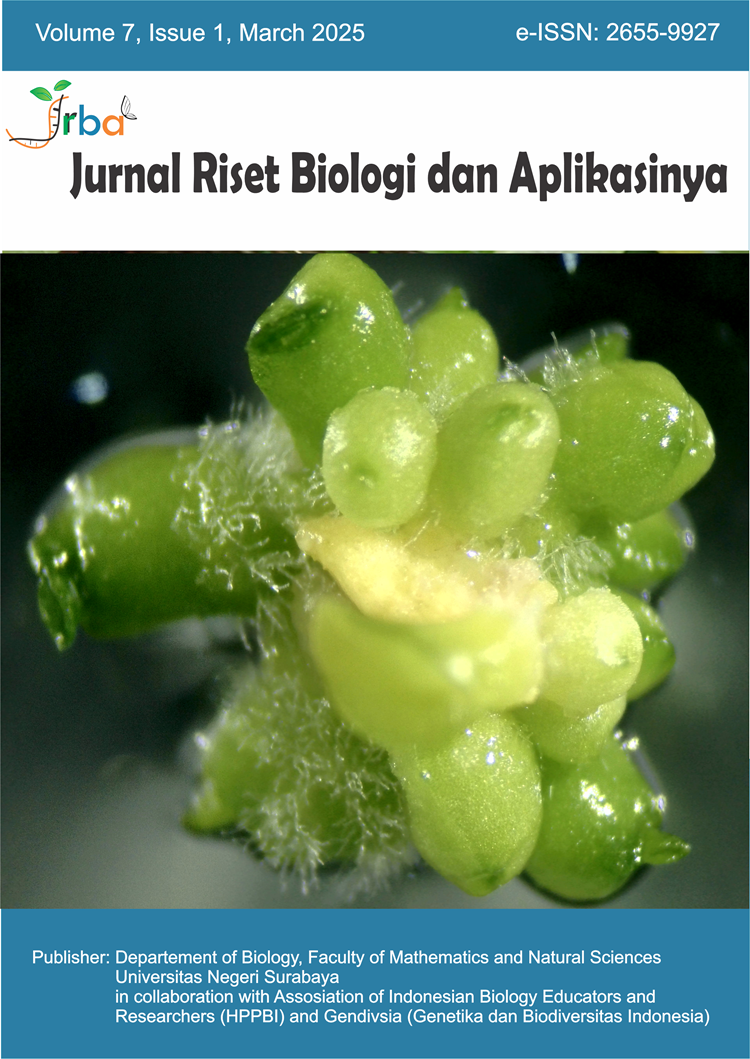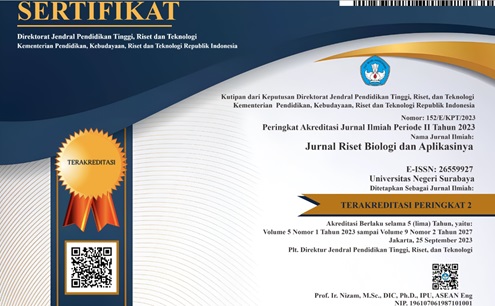The Therapeutic Potential of Humic Acid in Streptozotocin-Induced Hyperglycemic White Rats (Rattus norvegicus L.)
DOI:
https://doi.org/10.26740/jrba.v7n1.p110-117Keywords:
Glucose; body weight; insulin secretion; MDAAbstract
Humic acid, an organic compound from peat soil, rich in antioxidants such as quinone and phenol, shows potential as an antidiabetic agent. This study aims to identify the optimal dose of humic acid extract for increasing body weight, lowering blood glucose levels, reducing malondialdehyde (MDA) levels, and improving the microanatomical structure of the pancreas in streptozotocin-induced diabetic rats. The humic acid was extracted from peat soil at Tanjungpura University. The study utilized 25 male Wistar rats (Rattus norvegicus), aged 8-12 weeks, organized in a group randomized design (GRD). Interventions included a single dose of streptozotocin (40 mg/kg b.w.) and varying doses of humic acid extract administered over 14 days post-induction. Results indicated that a dose of 375 mg/kg b.w. humic acid extract resulted in an increased final body weight by 11.86%, a reduction in fasting blood glucose levels by 79.23%, an AUC0-120 value of 19.311, and a final MDA level of 1.09 ±0.27 nmol/ml. These findings indicate the potential of humic acid as a therapeutic agent for diabetes.
References
Abiola, T.S., David, O.O., & Olatunde, F.E. (2021). Effect of Tannin-Rich Extract of Chasmanthera dependens on Piroxicam-induced Liver Damage in Male Wistar Rats. Mol Cell Biomed Sci, 5(1), 27-36. https://doi.org/10.21705/mcbs.v5i1.186.
Aeschbacher, M., Graf, C., Schwarzenbach, R.P., & Sander, M. (2012). Antioxidant properties of humic substances. Environmental Science & Technology, 46 (9), 4916-4925. https://doi.org/10.1021/es300039h
Agazzi, A., Cigalino, G., Mancini, G., Savoini, G. & Dell’Orto, V. (2006). Effects of Dietary Humates on Growth and An Aspect of Cell-mediated Immune Response in Newborn Kids. Small Ruminant Research, 72 (2), 242– 245. https://doi.org/10.1016/j.smallrumres.2006.10.020
Angeles, M. L., Gómez-Rosales, S., & Téllez-Isaias, G. (2022). Mechanisms of Action of Humic Substances as Growth Promoters in Animals. https://doi.org/10.5772/intechopen.105956
Ayuwardani, N. & Susilowati. (2018). The Effect of Diet on Plasma Malondialdehyde Levels as an Effort to Prevent Diabetes Mellitus in Adolescents. Nursing Journal, 11(2), 6-14. https://e-journal.lppmdianhusada.ac.id/index.php/jk/article/view/18.
Csicsor, A., Tombácz, E., Kulcsár, P. (2023). Antioxidant potential of humic substances measured by Folin-Ciocalteu, Cuprac, Quencher-Cuprac and ESR methods. Journal of Molecular Liquids, 391(B). https://doi.org/10.1016/j.molliq.2023.123294
Eleazu, C.O, Eleazu, K.C, Chukwuma, S, & Essien, U.S. (2013). Review of the Mechanism of Cell Death Resulting from Streptozotocin Challenge in Experimental Animals, its Practical Use and Potential Risk to Humans. J. Diabetes Metab Disord. 12 (1), 60-72. https://doi.org/10.1186/2251-6581-12-60
Ghasemi, A. & Jeddi, S. (2023). Streptozotocin as a tool for induction of rat models of diabetes: a practical guide. Excli J, 22(2), 274–294. https://doi.org/10.17179/excli2022-5720.
Hafsa, S. H., Hassan, A. A., Sabek, A., Elghandour, M. M. M. Y., Barbabosa-Pliego, A., Alqaisi, O., & Salem, A. Z. M. (2021). Extracted and Characterized Humic Substances as Feed Supplement in Rabbit Feeding: Effects on Performance, Blood Metabolites and Caecal Fermentation Activity. Waste and Biomass Valorization, 12(10), 5471-5479. https://doi.org/10.1007/s12649-021-01392-3
Herawati, A., Aulanni’am, Prasetyawan, S. (2012). The role of d-alpha tocopherol Therapy to Blood Glucose Levels and Levels of MDA (malondialdehyde) in diabetes mellitus Type 1 Rats by MLD-STZ. Veterinaria Medika, 5(3), 195-200.
Hussain, A., Ali, I., Khan, A.U., & Khan, T.M. (2016). Glibenclamide-induced profound hypoglycaemic crisis: a case report. Ther Adv Endocrinol Metab. 7(2),84-7. https://doi.org/10.1177/2042018816632440
Jiang, F., Zhou, L., Zhang, C., Jiang, H., & Xu, Z. (2023). Malondialdehyde Levels in Diabetic Retinopathy Patients: A Systematic Review and Meta-Analysis. Chin Med J (Engl), 136(11), 1311–1321. https://doi.org/10.1097/CM9.0000000000002620
Kodama, H. & Denso. (2007). Antitumor Effect of Humus Extract on Murine Transplantable L1210 Leukemia, Vet. Med. Sci, 69(10): 1069-1071. https://doi.org/0.1292/jvms.69.1069
Mohmed, A.R., Elsebai, A., Elghalid, O.A., Abd El-Hady, A.M. (2020). Productive performance, lipid profile and caecum microbial counts of growing rabbits treated with humic acid. Journal of Animal and Physiological Nutrition, 104 (1), 1233-1241. https://doi.org/10.1111/jpn.13352
Rehman, H., Ullah, K., Rasool, A., Manzoor, R., Yuan, Y., Tareen, A.M., Kaleem, I., Riaz, N., Hameed, S., & Shahid, B. (2023). Comparative impact of streptozotocin on altering normal glucose homeostasis in diabetic rats compared to normoglycemic rats. Scientific Reports, 13(7921), 23-37. https://doi.org/10.1038/s41598-023-29445-8
Rusliandi, Rousdy, D.W., & Mukarlina. (2020). The Anti-Inflammatory Activity of Humic Acid from Borneo Peat Soil in Mice. Traditional Medicine Journal, 25(1), 22-28. https://doi.org/10.22146/mot.48003.
Sakaguchi, K., Takeda, K., Maeda, M., Ogawa, W., Sato, T., Okada, S., Ohnishi, Y., Nakajima, H., & Kashiwahi, A. (2016). Glucose area under the curve during oral glucose tolerance test as an index of glucose intolerance. Diabetology International, 7(1), 53–58 https://doi.org/10.1007/s13340-015-02124
Sami, W., Ansari, T., Butt, N.S., Hamid, M.R.A. (2017). Effect of diet on type 2 diabetes mellitus: A review. Int J Health Sci (Qassim), 11(2), 65-71.
Santoso, S., Rachmawati, B., & Retnoningrum, D. (2018). Differences in the, Number of Leukocytes, Neutrophils, and Absolute Lymphocytes in Controlled and Uncontrolled Type 2 Diabetes Mellitus Patients. Diponegoro Medical Journal. 7(2), 2540-8844. https://doi.org/10.1186/s12902-024-01637-x
Spilioti, E., Vargiami, M., Letsiou, S., Gardikis, K., Sygouni, V., & Koutsoukos, P. (2017). Biological properties of mud extracts derived from various SPA resorts. Environmental Geochemistry and Health, 39, 821–833. https://doi.org/10.1007/s10653-016-9852-y
Suryawanshi, N.P., Bhutey, A.K., Nagdeote, A.N., Jadhav, A.A., & Manookar, G.S. (2006). Study of Lipid Peroxide and Lipid Profile in Diabetes Mellitus. Indian J Clin Biochem, 21(1),126-30. https://doi.org/10.1007/BF02913080
Trckova, M., Lorencova, A., Babak, V., Neca, J., & Ciganek, M. (2018). The effect of leonardite and lignite on the health of weaned piglets. Research in Veterinary Science, 119(1), 134-142. https://doi.org/10.1016/j.rvsc.2018.06.004
Unnikrishnan, R. (2017). Type 2 Diabetes: Demystifying the Global Epidemic. Diabetes, 66(1), 1432–1442. https://doi.org/10.2337/db16-0766
Vetvicka, V., Garcia-Mina, J.M., Proctor, M., & Yvin J-C. (2014). Synergistic Effects of Humic Acid and Glucan in Hepatoprotection Against Experimental Liver Injury. Austin Journal of Clinical Pathology. 1 (4),1020.
Vetvicka, V., Garcia-Mina, J.M., Yvin, J.C. (2015). Prophylactic Effects of Humic Acid-Glucan Combination Against Experimental Liver Injury. Journal of Interculture Ethnopharmacology, 4 (1), 249-255. https://doi.org/10.5455/jice.20150519103113
Wang, D., You, Z., Du, Y., Zheng, D., Jia, H., & Liu, Y. (2022). Influence of Sodium Humate on the Growth Performance, Diarrhea Incidence, Blood Parameters, and Fecal Microflora of Pre-Weaned Dairy Calves. Animals, 12 (1), 123. https://doi.org/10.3390/ani12010123
Yasin, Y.K., Kartasurya, M.I, & Kisdjamiatun, R.A. (2015). The Effect of Vitamin C and Vitamin E Combination on Plasma Malondialdehyde Levels in Type 2 Diabetes Mellitus Patients. The Indonesian Journal of Nutrition, 4(1), 1-8. https://doi.org/10.21456/vol%25viss%25ipp1-11.
Yustiawati, Y., Sazawa, K., Kihara, Y & Kuramitz, H. (2014). Effects of peat fires on the characteristics of humic acid extracted from peat soil in Central Kalimantan, Indonesia. Environmental Science and Pollution Research, 22(4), 22-37. http://dx.doi.org/10.1007/s11356-014-2929-1
Downloads
Published
How to Cite
Issue
Section
License
Copyright (c) 2025 Jurnal Riset Biologi dan Aplikasinya

This work is licensed under a Creative Commons Attribution-NonCommercial 4.0 International License.
 Abstract views: 239
,
Abstract views: 239
, PDF Downloads: 200
PDF Downloads: 200












